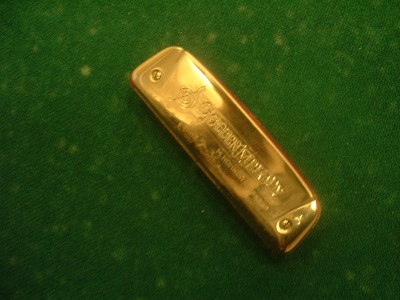Ladies and Gentlemen, I am massively confused when it comes to theory. I hate theory. I once went to a jam and sat down with another harp player. I’d brought all my different harps to show off. He gawked blankly at me, then he took his little C out, stepped up to the mike with the band and blew me away. Learning theory is just going to show me there is so much more that I can’t do and how much I need to practice. So if you just want to just have fun and remain ignorant of how or why your instrument works, don’t turn the page.
I figured, well, I can play it, so I can understand it. Right? WRONG! Ionian, Mixolydian, Dorian. I put the harmonica in my mouth and I end up playing in all these modes, but I can barely understand it and certainly couldn’t explain it easily. It is a lot like Dan Grigor says. In the Pentatonic Blues you only use five notes, and they all sound good, so as long as you are in rhythm it doesn’t matter what note you play. Crossharp puts you in a mixolydian pentatonic scale (just mixing that lydian with that pentatonic), so no matter what note you play you are doing good. You can go sliding, walking… whatever you want.
Don’t worry if you don’t understand. I am learning as I go, too. This stuff just is, and it works. This is about learning as little as possible and trying to build on that, because theory means nothing without practice. So let’s keep this simple and stay in open C because it has no flats and sharps. In C you have access to a bunch of keys and scales. All this can be extrapolated to the other keys of the harmonica later on.
Step 1: This is what your instrument looks like. If you think this is too simple , then let me tell you that from the first time I put a harmonica in my mouth for years I had no idea about keys or what the individual notes were. It is good if you just do scales of individual notes until you can recognize them by ear. If you can do that you are a much better man than I, Gunga Din.
The catch here – and the thing that will keep you from learning theory – is: You don’t need to know how the harmonica works because it is hardwired and the notes cannot be changed. The tuning that makes it so easy to play was designed by a guy named Richter, who presumably understood a bit about keys and scales. There are seven notes on a chromatic scale, that is A to G. A diatonic harmonica has six holes per octave. In the first octave, however, there are only five notes, because the G is repeated on the blow and the draw.
Step 2: This is what your instrument is capable of. Any harmonica can play in several keys and modes. That means, depending on what the band is doing you have to find the right harmonica in the right mode. There are different ways to do this. If you have no idea about keys or modes you can (1) just keep trying out different harmonicas in different positions, sliding up and down with a quizzical expression, while the band is playing, which looks pretty unprofessional, OR (2) with a little knowledge you can ask “What key are we in?” and then, from your beautiful gun belt of harps slung across your chest you can pick just the perfect harp which suits the mood you want to convey. By the way, two is the correct answer, and I have little charts stuck onto my cases to remind me just how to find the right key, because sometimes it is complicated, like for instance, if you want to play cross in a relative key.
A C major harp can play in the following keys and modes:
C major. Your root note is the very first hole. That is blow. The scale is called Ionian, or Straight Harp. Don’t ask me why. The notes available to you are CDEGGB. Above that there are two more octaves you can play with, if you wish to get fancy. You can also start playing C in the middle position, that is fourth hole blow. This is where I usually play, unless I am playing somewhere else.
G major. Your root note is the second hole, draw. That means breathe in. This scale is called Mixolydian. The notes available to to are GBCDEF.
D major. Your root note is on the fourth hole draw. The notes available to you are DEFGAB.
A minor. You play this like you would play C major, because C is the relative major for the A minor key. Minor keys offer different melodic possibilities than major keys. I say this because I sense this intuitively when I play, and because there are tons of lyrics about the sadness of the minor key, not because I know any theory to back it up. But, mostly, knowing the relative keys means you don’t have to sound stupid at music stores looking for minor key harmonicas. I understand they can be special ordered, but they are expensive, and pointless really.
Figure out the cross and third positions for the relative mode and you have access to two more minor keys.
There are more modes I have not mentioned here and each mode is a different key and scale, providing different melodic possibilities when playing, but to summarize: On a C harp you can play in these different keys: C, G, D, A minor…
I mentioned that cross harp is Mixolydian. I also said don’t ask me what Mixolydian was. However, the following songs are in Mixolydian. The best thing you could do is find these songs, find out what key they are in, and then pick the appropriate harp in cross. If you don’t know the key of song then just play along with a few different harmonicas until it sounds right. But the first thing to do when playing with these pieces is just to forget all that I’ve told you and go with the music.
If you think about it your playing will be dry and stilted. That’s where the practice comes in, making the theory part of you. This is the frustrating part for me, because I know the possibilities for extending the instrument’s capabilities are there, and by playing I may even begin utilizing these possibilities, but the only way to understand and control what I am doing is to study and play and study and play.
She Moved Through the Fair. The harp is not just for blues, you know. In this particular version I would follow the strings. The place for the harp here is behind the voice, acting in harmony with it. For the guitarists there are also some incredible versions of this by Davey Graham and Jimmie Page on Youtube. But that’s a bit beyond what I was talking about here. I have tried to play along just for fun.
Norwegian Wood by the Beatles. Knock yourself out. I have no idea where this is going for you. Pick the key by ear, unless you are a Beatles junky and know what key they played this in. Harmony, rhythm, melody… Whatever you do it will probably require a different mode on a different harp for each. There are so many possibilities here.
Sweet Home Alabama by Lynyrd Skynyrd. Here’s some Country Fried Myxolydian Blues. Knock yourself out again. Here’s a puzzle for you. A C harp, fourth hole draw works on this. That’s the key of D for you, the harp player. Does that mean the band is playing in D or B minor? Or is the band in C (or A minor) because it is a C harmonica? It is so much easier when you have the guitar player next to you and you can say “Hey, man, what’s the key?” And sometimes he doesn’t know either.
However, this is my take, which may be kind of weird, so you have to find your own way. Wiki says about playing D on a C harp: “Third position… Dorian scale between 4 draw and 8 draw… On a diatonic, starting hole is hole 1 draw. On a C-chromatic, starting hole is hole 1 draw, resulting in D-minor with a raised 6th.” So the band is in D. I always play one octave up, so when the rule on the diatonic says first hole draw, I end up playing 4th hole draw on a diatonic, and 5th hole draw on a chromatic, which are both D, and on a chromatic you get a nice minor scale. I never planned it that way. I just played in the middle of the harmonica when I didn’t know any better and then it became natural for me. I always figured I could swing both ways, if you get my meaning. Try the chromatic in this key, because it will give you a cool minor melodic feel with a flatted 6th (whatever that means- it actually means you have access to an extra note).

Now if anybody understood what I was talking about maybe you could get back to me and explain it to me, because I, personally, am a bit at sea here and I may be doing more to add to confusion than clarify things. But, you know, I have travelled a bit and I have found that the best way to get to know a place is to lose yourself in it, and, if you survive, you end up finding yourself in the process.
If you don’t mind, I will get back to my playing. I’m much more comfortable when I don’t have to talk about it, because it just seems to work when I play and I can stop thinking so hard, if you know what I mean.




